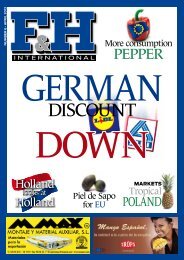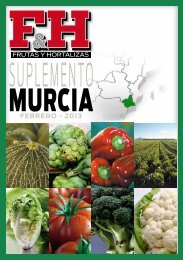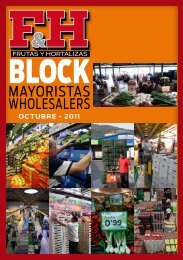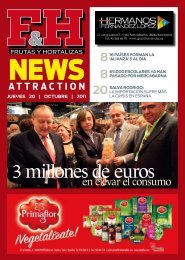Reporting On... - Revista F&H
Reporting On... - Revista F&H
Reporting On... - Revista F&H
Create successful ePaper yourself
Turn your PDF publications into a flip-book with our unique Google optimized e-Paper software.
16<br />
NORDIC MARKETS<br />
THE FRUIT TRADE IN THE<br />
NORDIC COUNTRIES IS<br />
SUBjECT TO THE PARTICU-<br />
LAR FEATURES OF THESE<br />
COUNTRIES: FROM CLI-<br />
MATIC CONDITIONS AND<br />
THE LOCAL HORTICUL-<br />
TURE TO THE CHARAC-<br />
TERISTICS OF CONSUMP-<br />
TION PATTERNS.<br />
By Uwe Schwießelmann<br />
uwe@fyh.es<br />
Domestic Horticulture and<br />
Imports. The Scandinavian<br />
climate naturally restricts the<br />
number of outdoor crops and<br />
makes greenhouse growing<br />
very cost-intensive. Due to<br />
the low temperatures, many<br />
products have to be cultivated<br />
in glasshouses (e.g. in<br />
Sweden, greenhouse crops<br />
account for half the value of<br />
horticultural production):<br />
100 per cent of tomatoes,<br />
close to 80 per cent of cucumbers,<br />
and an increasing<br />
proportion of berries. But<br />
taking into account the elevated<br />
costs of heating, it is<br />
logical that to compete with<br />
often extremly cheap im-<br />
The Peculiar<br />
Case of Finland<br />
Though, with little more<br />
than 5 m inhabitants,<br />
Finland is not exactly a<br />
point of reference for the<br />
international fruit or food<br />
retail trade, it certainly<br />
presents a curious picture<br />
inasmuch as internationalization<br />
– or rather the<br />
lack of it – is concerned.<br />
At the same time, the<br />
degree of concentration<br />
is even higher than in<br />
other Nordic countries.<br />
Sales of the S Group,<br />
ports is very complicated. As<br />
far as outdoors horticulture<br />
is concerned, volumes of lettuce<br />
(especially iceberg), carrots,<br />
and onions are worth<br />
mentioning, though in Sweden,<br />
for example, strawberries<br />
represent the highest<br />
value (about 27 me) of all<br />
outdoors crops. Apart from<br />
berries, apples and pears,<br />
above all in Sweden, outdoors<br />
fruit production is not<br />
really important. So, the Nordic<br />
countries heavily depend<br />
on imports of fresh fruits and<br />
vegetables: their market share<br />
is about 95 and 60 per cent,<br />
respectively. For many years,<br />
the Netherlands, followed<br />
F&H International 1 • November 2011 <strong>Reporting</strong> <strong>On</strong>...<br />
Things to know about the<br />
Nordic<br />
Markets<br />
owned by regional and<br />
local Finish companies,<br />
represent an amazing<br />
44,1 per cent of the domestic<br />
food market. Its<br />
biggest competitor, Finish<br />
Kesko Corporation,<br />
which, apart from all<br />
Nordic countries except<br />
Denmark, operates in the<br />
Baltic States, Russia, and<br />
Belarus, runs over 1,000<br />
K-food stores in Finland<br />
which account for 35<br />
per cent of the market.<br />
9 per cent correspond to<br />
Suomen Lähikauppa Oy<br />
(formerly Tradeca Ltd.);<br />
Lidl accounts for about<br />
4,8 per cent.<br />
by Spain and Germany, have<br />
been the most important suppliers<br />
to the Nordic markets.<br />
<strong>On</strong>ly in the case of Denmark,<br />
imports from Spain are exceeded<br />
by shipments from<br />
Germany. The leadership of<br />
the Netherlands reflects, in<br />
the first place, the country’s<br />
role as central trans-shipment<br />
place and re-exporter. In the<br />
case of Germany, apart from<br />
bordering Denmark, we have<br />
to take into account, that<br />
Lidl and Edeka, for example,<br />
are supplied by these multinationals’<br />
Germany-based<br />
fresh-produce distribution<br />
centres.<br />
The Nordic Consumers. The<br />
Nordic markets have always<br />
stood out for consumers’<br />
high purchasing power as<br />
compared to the European<br />
average: up to 160 per cent<br />
in the case of Norwegians<br />
(food prices are 43 per cent<br />
above European average).<br />
Other characteristics include<br />
a marked environmental<br />
awareness; the importance of<br />
healthy, safe and functional<br />
food products; the prominent<br />
role of organic food in<br />
these countries; the high degree<br />
of consumers’ consciousness<br />
concerning the ethical<br />
aspects of the sustainability<br />
concept (fair trade products);<br />
the orientation towards highquality,<br />
added-value products;<br />
and an inclination of<br />
consumers to favour regional<br />
produce. All this may still be<br />
true, to a certain degree, but<br />
there can be no doubt that<br />
the picture has been modifying<br />
over the last few years.<br />
“The decrease in the tomatoes<br />
growing area in Sweden<br />
is due to the availability of<br />
much cheaper imports which<br />
is why there is no market for<br />
Swedish tomatoes. So much<br />
for the topic of consumers’<br />
preference for regional products...”<br />
M Peter Horvath, Purchasing<br />
Manager Fruit and<br />
Vegetables at Saba Frukt &<br />
Grönt.<br />
The Importance of the Discount<br />
Concept.<br />
The most significant change<br />
in the consumption patterns<br />
is an increase in the importance<br />
of price. The expansion<br />
of big discount retail chains<br />
on these markets, has clearly<br />
had a series of repercussions.<br />
<strong>On</strong> the one hand, it accelerated<br />
the process of concentration<br />
of the food trade and<br />
intensified the concentration<br />
on prices to the detriment<br />
of quality-orientation,<br />
on the other hand, it forced<br />
retail chains to establish or<br />
reinforce their own discount<br />
concepts. So, Swedish ICA<br />
and Dansk Supermarked<br />
combined forces in a joint<br />
venture to operate Netto discount<br />
stores in Sweden (over<br />
100) and Norway; in addition,<br />
Dansk Supermarked<br />
operates more than 400 Netto<br />
stores in Denmark. With<br />
164 stores, ‘Willys’ (Axfood)<br />
is Sweden’s leading discount<br />
chain. Aldi, the German discount<br />
legend, runs 230 stores<br />
in Denmark.
















